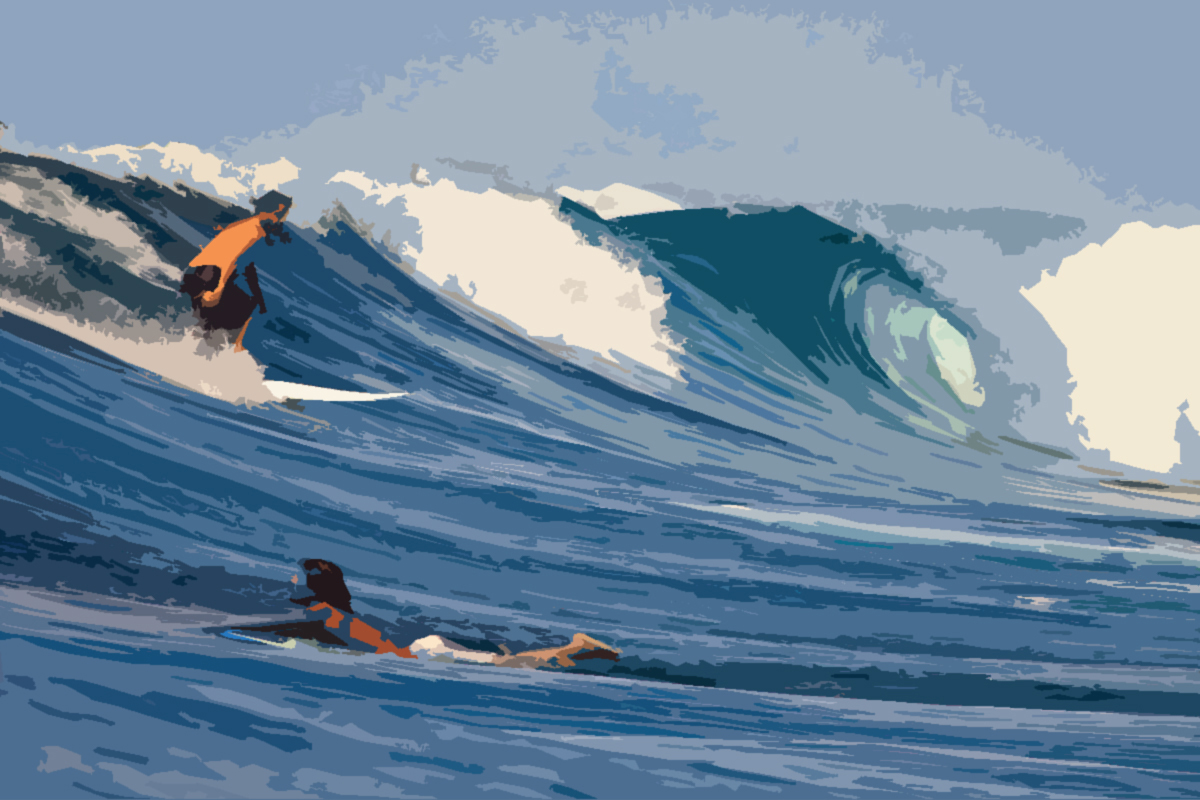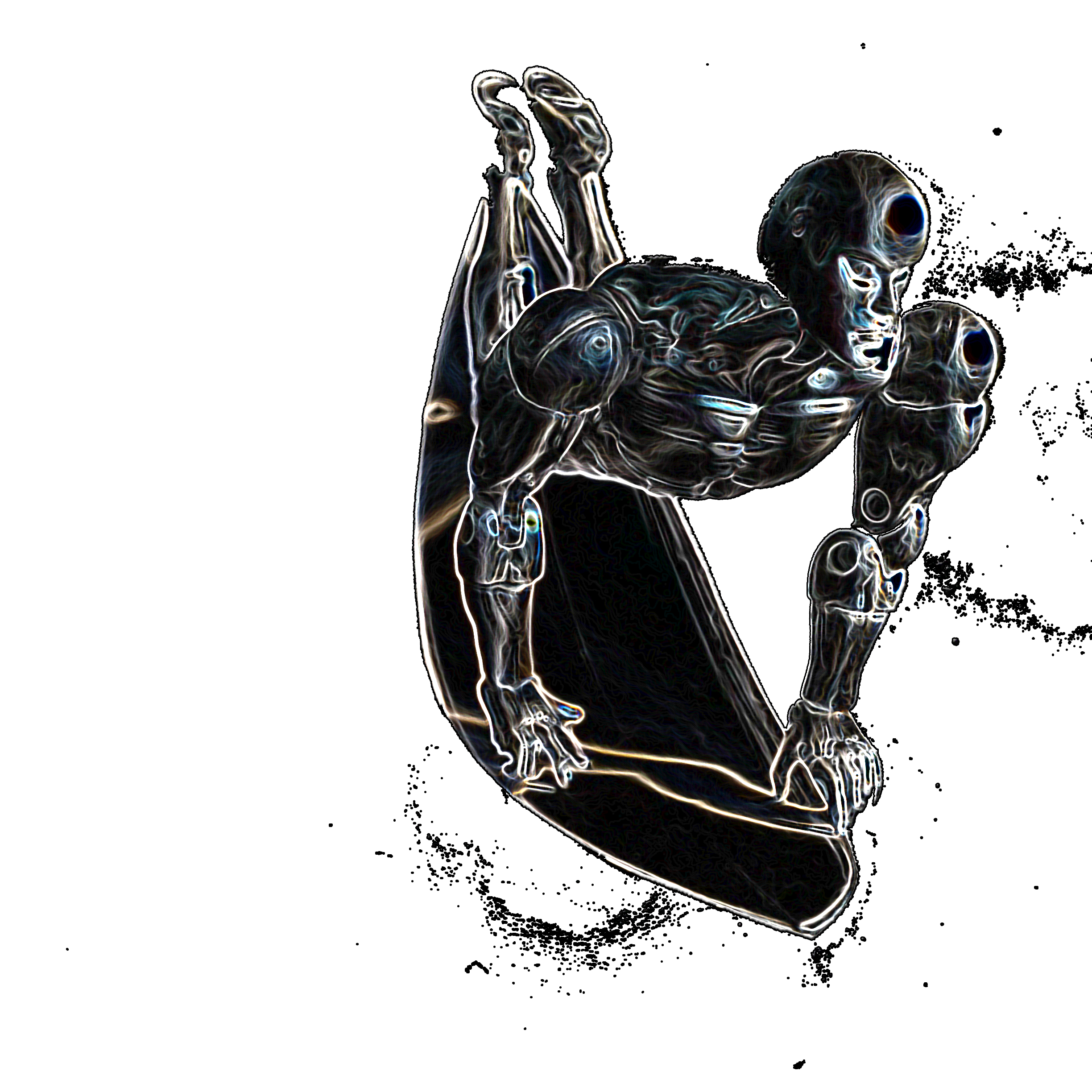GEOMETRIC THINKING: To condition our imagination, let's start by getting into the water: A few strokes of the oar to reach the peak, or more if the bar is strong, and here we are, calmly posed, to recover effort. Still set back, the surfer enters the music while observing the coming swell. Breathing becomes fuller, deeper as you soak up the spectacle of this place. Wave reading is done naturally, in silence, it is contemplative: The lines, drawn out to sea, capture all the attention. The series of waves that appear, blurs the last thoughts that still polluted the attention. The wave arrives and rocks majestically by ejecting its lip. The gaze memorizes the position of the peak, and follows the surge. The hollow zone traces its vertical partition in space. The spectacle of the trajectory of surfer friends energizes us, empathy sublimates the moment.
 We imagine a trajectory in the last wave that we let pass, the desire for action carries us away and we climb to place ourselves at the peak. It is here that the wave begins its end, we are here to testify respectfully:
We imagine a trajectory in the last wave that we let pass, the desire for action carries us away and we climb to place ourselves at the peak. It is here that the wave begins its end, we are here to testify respectfully:
1. Powerful rowing movements, flapping, as in this dream, where one manages to fly, grant the speed of the board on the wave which arrives at its point of breaking,
2. Seismic surge of the swell wave, tilting, free fall, disappearance of weight, these are the triggers of the take off reflex,
3. The acceleration released by the slope increases the pressure under the board, when planing, the standing position becomes naturally stable, it slides, it flies!
4. The flow vibrates under the board, its note resounds in our feet, to go up our spine. His music transmits to us the texture of contact, like the sapphire in the groove of an old LP that transports us to the dark side of the moon.. 
5. I'm aiming for the Still-point…
The time allowed to read these 5 lines is 20 times longer than the duration of the real action. If the scene was thought of as this pleasant memory of the event, the brain would never have known how to formulate and order the series of gestures necessary for its success. When you surf you don't think, otherwise the objective disappears, masked by thoughts. By reaching the peak, the surfer switched to "geometric thinking". This visual method of designing projects is faster than thought because it is not “formulated”. When the geometry of the moment completely fills the surfer's mind, the subjective image of the wave reveals guide curves. Nothing mystical, just transformations of landmarks and alignments, all sailors know that.
The Still-point symbolizes the surfer's quest, but it also has a physical dimension. How does the Still point serve as a geometric guide for improvising trajectories? This question deserves a chapter: The still point, the heart of surfing?
Note on INTUITIVE ACTION:
It is particularly delicate to mix technical analysis and sensations, so we must rule out misunderstandings by agreeing on the meaning, debatable but defined, which is given to the intuitiveness of an action on the pages of this site. We are all different, and these definitions are without scientific or philosophical pretensions, they can only be subjective, and maybe define their author more than anything else.

•Let us consider intuition as an event preceding reasoning: At the stage of intuition, the sensory influx is not yet formulated in thought, it is a sensation. Let us therefore admit here that intuition is the grouping of data from several of our senses, into a single global sensation, drawing an image of the present in our mind.
• Thought: Thought reformulates this sensation, it interprets the image of intuition. Thought compares and processes the sensory image with reasoned intellectual methods. Thought stores its concepts in words, which it successively formulates in mental space to extract a sentence, an overall meaning. We think by reading our inner words. This action of thought temporarily focuses the attention away from the present external event, in the same way that we ignore our breathing while reading these lines.
• The intuitiveness of an action depends on the share of data that thought must process to control it. A reflex is intuitive because it uses no thought. A tool is intuitive when it is adapted to natural gestures, its user does not need a complex user manual to understand and use it. It is possible to decrease the processing carried out by the thought to carry out a given action, by carrying out ranges of movements repeated so that they enter memory as reflexes. The part of consciousness occupied during their realization will thus be reduced, and a complex chain of actions can become more intuitive.

This being said we can address: the maneuverability of the surf.